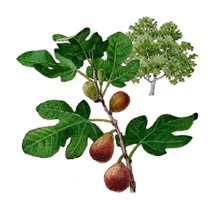Chesapeake Bay's Independent Newspaper ~ Since 1993
1629 Forest Drive, Annapolis, MD 21403 ~ 410-626-9888
Volume xviii, Issue 24 ~ June 17 to June 23, 2010
Home \\ Correspondence \\ from the Editor \\ Submit a Letter \\ Classifieds \\ Contact Us
Best of the Bay \\ Dining Guide \\ Home & Garden Guide \\ Archives \\ Distribution \\ Advertising![]()


The Bay Gardener |
There Will Be Figs
With lots of fruit and few demands,
what’s not to like?
There is nothing like eating a freshly picked ripe fig. They are as sweet as honey and taste heavenly. There is no reason why every home gardener should not be growing at least one fig plant.
Contrary to my earlier predictions, the tops of the fig plants were not killed by the severe winter. Matter of fact, figs are growing in almost every node of each stem of the plants growing outside our bedroom window.
Last year, most of the fig plants in our area were killed back half-way and frequently down to the ground. When the tops of figs are killed severely, the new stems will only produce a fall crop of figs, which often just start to mature when they are killed by the first frost.
It is likely that we will be harvesting two crops of figs this year — provided we have a late frost.
Fig plants like hot, dry conditions such as those on the south side of your home. They need full sun, and they receive winter protection by being planted close to the house. They thrive on the reflected summer heat from the walls of the house and require watering only during the driest of growing season. They are extremely drought-tolerant. There are no disease or insects that feed on them.
Figs are at their best when harvested when the fruit is drooping and dripping with syrup. The brown turkey fig has a brownish purple top and green bottom and is slightly larger than a golf ball in size. The golden Egyptian fig is smaller and yellow-green.
The fruit is harvested over a period of several weeks. Egyptian figs’ first harvest comes in July and brown turkey figs’ in August.
The plants are easily propagated by bending a branch to the ground and covering it with soil. Cracking the branch slightly before covering it will hasten rooting. By fall, the stem will have rooted and be ready to dig up and transplant.
Where to Get Bt
Q I have a water pond with lily plants. I have some kind of worm that is putting holes in the leaves. I was told to use Bt Thuracide to spray on the leaves. Where can I buy this product?
–Marty Mulligan, by email
A Bt, a naturally occurring soil organism used as a pesticide, is available either as Thuracide or as Dipel. Both are available from Southern States in Upper Marlboro or at Bowens Farm Supply in Parole.
Ask Dr. Gouin your questions at [email protected]. All questions will appear in Bay Weekly. Please include your name and address.
© COPYRIGHT 2010 by New Bay Enterprises, Inc. All rights reserved.
